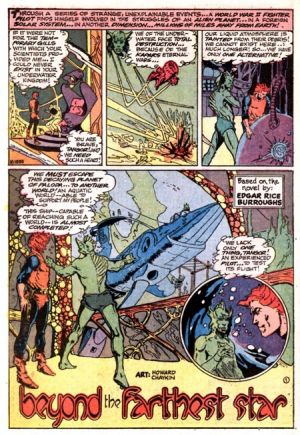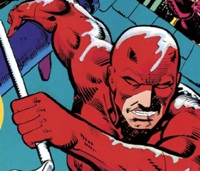Comics /
Cult Favorite
Storytellers Weekend, pt. 1 of 8:The Language of Comics
By Philip Schweier
March 10, 2010 - 12:35
On Feb. 19 and 20, the Savannah College of Art & Design hosted comic book creators Howard Chaykin and Klaus Janson, who presented a two-day seminar originally conceived for Marvel Comics. The purpose of the seminar is to introduce new comic artists and Marvel editors, some of whom come from an editorial background and lack the experience to effectively judge comic book techniques, to basic tools of effectively telling a story in the comic book form.
Janson asked Chaykin to participate because it seemed to the both of them and the industry at large that there is a disconnect between what comics are and what they were thought to be. “It always seemed to me that from the layman’s perspective, it’s a series of pictures of guys in tights,” says Chaykin, “and this is not the case.”
Among the things that both artists say they have learned during their careers is that there is a language and a vocabulary, and while they may disagree on specifics, in general terms they’re on the same page.
 |
| Some of Chaykin's earliest work, from DC Comics' Tarzan #216 |
“One point we need to be clear here,” says Chaykin, “is that we are not talking about drawing. We’re talking about visual narrative. We’re talking about the set of rules and languages that apply to people who draw like Charles Schulz, like Milton Caniff, like Jim Lee. It’s the basics of what we do.”
Janson agrees. “The basics of storytelling apply across the board to all venues and all types of publishing. Whether you’re working for Top Shelf, whether you’re doing your stuff in your basement, whether you’re working for Marvel or DC, the ability to tell a story has certain fundamental rules that apply across the board and should not be ignored. In order to communicate, there are certain rules that have to be acknowledged.”
In addition to his comics career, Janson also teaches at the School of Visual Arts (SVA) in New York City. “I know that there are certain common things that students repeat over and over, year after year, the same mistakes, and I’ve noticed this through the years.
He explains that for many artists, there is often a period of time where an artist breaks in, and the first 10 years of their careers produces a lot of substandard work that is ultimately embarrassing.
 |
| Daredevil, by Frank Miller and Klaus Janson |
“Speaking personally,” explains Janson “it wasn’t until I got on to
Daredevil with Frank Miller that I was able to produce work that was at least decent, that had some merit to it. And it wasn’t because – you guys may think because Frank was attached to it, but we have to produce a lot more material very quickly. So I was able to pencil, ink and color the book monthly for about two years, and it was really producing a lot of work that made me better.”
Chaykin, who has been drawing comic books professionally since 1972, agrees. “I didn’t have the opportunity to do it in school, so I have 10 years of shame, but I did it in public, so I can’t disavow it. That was my education.”
One common mistake that Janson mentions is the inability to do two things in one panel at a time. The students break everything down into one panel and one action and one balloon, then another panel and one head and one action.
 |
| Eric Clapton |
He cites a recent Eric Clapton interview in
Rolling Stone in which the guitarist spoke of economy, wanting nothing more than to hit that one correct note, and follow it up with the next note that logically follows.
“I was struck by how close music is to what we do,” said Janson, “as opposed to film. A lot of people think that film and comics are really related, like sisters, but I think of them as more like cousins perhaps. I think music is much more connected to comics.”
“It’s something I agree with wholeheartedly,” says Chaykin. “What Klaus is alluding to is that movies are a kinetic medium, but comics are a static medium. We don’t really have motion. The only camera motion we have for the context of comics is deep space, and that kind of storytelling obviates the use of deep space.”
Janson explains that one of the things that Chaykin said to turn him around as far as depth was concerned: “I always used to tell my students we have to know depth in terms of working on two-dimensional paper, so there is no third dimension. There is no depth. When Howard and I started talking about this stuff, Howard’s phrase was, ‘We have nothing but depth.’ And he managed in that phrase to turn the entire thing upside down for me, and to turn a negative into a positive, and looking at it from that point of view, from the point of view of we have nothing but depth really was very illuminating.”
Next: The Artist's Job
Praise and adulation? Scorn and ridicule? E-mail me at philip@comicbookbin.com
Last Updated: March 3, 2025 - 20:40


